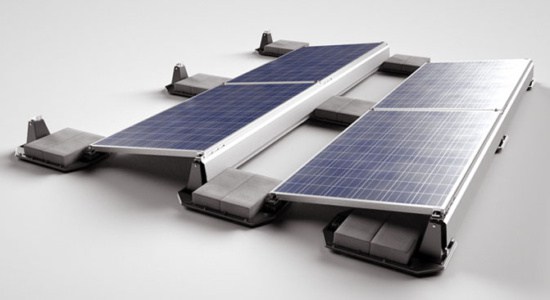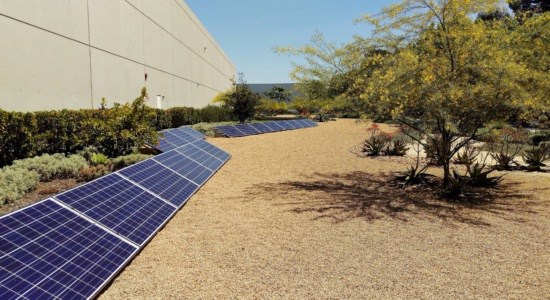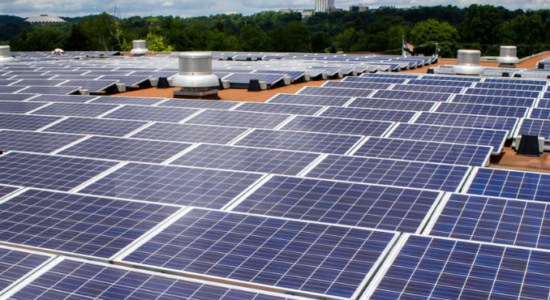Commercial Solar
How Commercial Solar Power Works
Harnessing solar energy to power your commercial building is a complex, fascinating process. Particles of sunlight called photons hit the solar panels on the roof of your building. The solar panels then convert the photons to electrons of direct current (DC) electricity which then are converted to alternating current (AC) electricity by the inverter. The converted energy then powers all the appliances in your building that are run by electricity, including lights, computer equipment, and kitchen appliances. Meanwhile, the utility meter measures the energy you use.
The Right Solar Type For You
What type of commercial solar installation is right for your business? Our expert team of solar project designers and engineers will examine your company’s facilities to determine the right approach. We manage and streamline the entire commercial solar process, from the initial evaluation and financing to construction and maintenance, effectively maximizing savings for your organization. Our initial analysis of your facility, as well as a preliminary project design recommendation comes standard in our free energy evaluation.
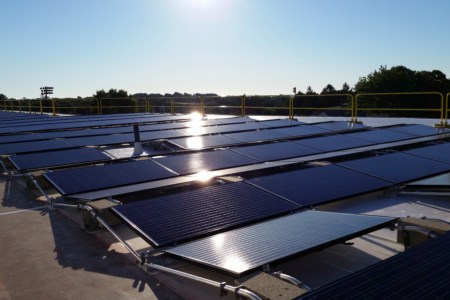
Rooftop Solar
When most people think of solar power, they think of solar panels that are attached to the roof of a house or building. Rooftop solar power systems are optimal for such commercial buildings with large, flat roofs. This is especially true for buildings that have been built within the past five years. Not only does employing a rooftop system give functionality to a largely under-utilized space, but a flat rooftop is ideal for performing necessary maintenance on solar panels over the years. Additionally, since flat rooftops are often not shaded, your system will receive maximum sun exposure, boosting your potential for harnessing solar energy.
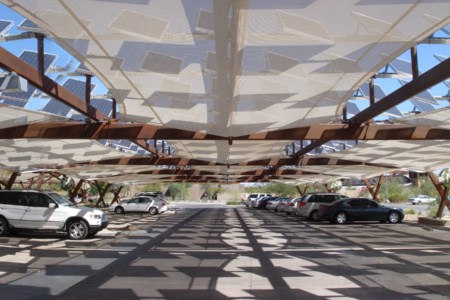
Solar Carport
A solar carport is an excellent option for businesses who wish to combine energy efficiency with functionality, since the carport will serve multiple purposes at once. Not only will your employees’ vehicles be kept shaded throughout the day from the scorching sun, but the solar panels on the roof of the carport will work to harness clean, renewable energy to power your commercial building. Solar carports are an elegant and efficient solution for businesses with rooftops that are not conducive to solar panels and don’t have available ground space.
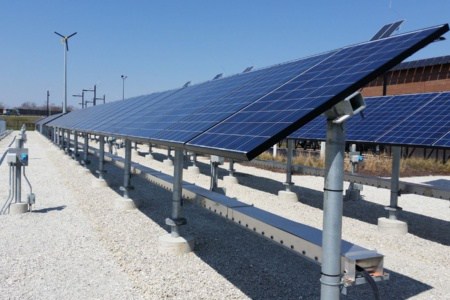
Solar Ground-Mount
Solar panels that are mounted on the ground tend to obtain the highest ROI (return on investment) due to the allowance for design, sizing, and layout that can optimize the system’s effectiveness. Ground-mounted projects are typically placed in open fields to limit and avoid potential sources of shading. This makes them similar to rooftop solar projects in that the panels receive maximum sunlight to be transferred into energy. Not only are ground-mounted solar projects the most efficient commercial systems to build, they're also the most economical. Ask a GST rep today about your commercial building’s potential for a solar ground-mount project.
Ballast Solar Mounting
Green Solar Technologies specializes in Ballast Solar Mounting.
If the construction of your building allows for neither rooftop, nor ground-mounted solar panels, you may wish to consider a ballast solar mount project. With solar ballast, concrete blocks are placed throughout a solar project to secure panels to the ground or roof without having to make holes in the surface. Ballast solar is an excellent alternative for business owners who can’t or don’t want to make holes in their roof or a ground surface, but still wish to harness solar energy and reap its benefits for maximum cost savings and environmental advantages.
Commercial Solar Process
From the initial call you make to one of our solar energy experts all the way through installation and beyond, Green Solar Technologies can assist you every step of the way. Transitioning to
solar energy is now easier than ever, and with solar pioneers with over 25 years of experience at the helm, your move to solar power should be simple, straightforward and rewarding.
Solar Consultation:
Initiation
- Initiation
- Solar Motivation
- Energy Timeline
Energy Analysis:
Modern Energy Plan
- Define Energy Goal
- Energy Evaluation
- Site Feasibility Assessment
Financial Agenda:
Contracts & Review
- Financing Options
- Finance Application
- Letter of Intent
Installation Process:
Plan of Action
- Sign General Contract
- Installation Target Date
- Installation Execution

